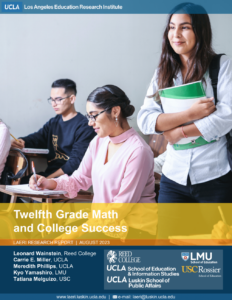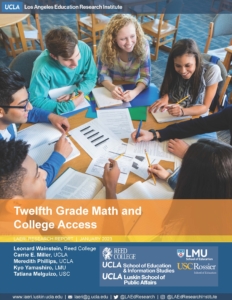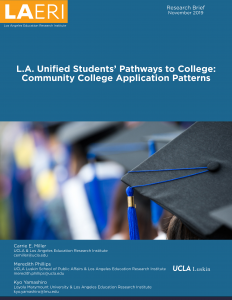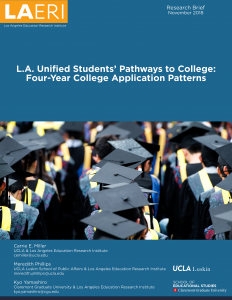Reports, Briefs, and Publications
News & Updates
This paper examines the long-term consequences of tracking in middle school. Using longitudinal administrative data from a large, urban school district and regression and quasi-experimental matching methods, we find that students who had the opportunity to take advanced math earned higher math test scores, completed more rigorous high school coursework, and were more likely to attend a four-year college. These effects largely hold across student subgroups and are relatively robust to omitted confounders. We explore some mechanisms underlying the short-term effects of taking advanced math and conclude that differences in classroom composition, rather than differences in teachers, help explain these effects. We conclude by discussing the implications of these results for efforts to improve educational equity.
Some high school seniors who plan to attend college in the fall following graduation do not enroll. This phenomenon, known as summer melt, contributes to lower educational attainment, particularly among low-income students. We extend the literature on summer melt in two ways. First, we show that melt estimates can be sensitive to measurement decisions and local context, and in particular that estimates based on student-level National Student Clearinghouse data can overstate the extent of summer melt. Second, we show that aspects of students’ behavior and perceptions, such as their attendance rates, FAFSA completion, and confidence about their intended college, predict summer melt. These results suggest ways that school staff and summer melt interventions could potentially target additional support to college-intending students to facilitate their successful transition to college.
This report examines the impact of taking a math course in twelfth grade on L.A. Unified students’ science, technology, engineering, and math (STEM) college course taking and academic achievement. We also investigate whether particular types of math courses (for example, Calculus or Statistics) are especially beneficial for students’ postsecondary success.
This report examines the effects of taking math in 12th grade on several academic outcomes, including high school grade point average, A-G course completion, college enrollment, and college persistence. We also investigate whether particular types of math courses (for example, Calculus or Statistics) are especially beneficial for students’ academic success.
This research brief from the LAERI—L.A. Unified research-practice partnership is the second in a series exploring Los Angeles Unified School District’s (L.A. Unified’s) students’ pathways to college. The first brief focused on twelfth graders from the class of 2017 who applied to at least one four-year college. This brief focuses on students from the same class who applied only to community colleges. We describe these students’ educational expectations and explanations for why they did not apply to a four-year college. The data for this brief come from a collaborative effort between LAERI and L.A. Unified to gather information about students’ experiences, behaviors, and supports during the college application process, using the district’s annual survey from the 2016-17 school year.
This research brief from the LAERI Research-Practice Partnership is the first in a series exploring Los Angeles Unified School District’s (L.A. Unified) students’ pathways to college. This brief focuses on students’ survey reports about whether and where they applied to college. It describes the percentage of twelfth graders from the class of 2017 who applied to college, where they applied to college, and how these patterns differed among young men and women and among students from different ethnic/racial backgrounds or academic preparation levels. The data for this brief come from a collaborative effort between LAERI and L.A. Unified to develop survey questions for L.A. Unified’s annual surveys about students’ experiences, behaviors, and supports during the college application process.
This report explores the availability of college readiness supports in LAUSD high schools. We draw on data collected from high school counselors and other organizations to describe the types of available supports and the barriers schools face in providing students the help they need with the college application and financial aid process. We conclude with recommendations for improving college readiness supports throughout the district.
This report, which is the first in-depth analysis of LAUSD graduates’ postsecondary outcomes, links data on college enrollment, persistence, and completion from the National Student Clearinghouse (NSC) with LAUSD data on students’ high school performance and ethnic and socioeconomic backgrounds. Our report examines where LAUSD graduates enrolled in college, as well as how college-going outcomes differed across a variety of background characteristics including gender, race/ethnicity, English learner status, family educational background, and students’ academic preparation during high school. We also describe postsecondary outcomes for the subset of LAUSD graduates who were eligible for admission to four-year colleges and offer recommendations for how the Los Angeles community can improve students’ postsecondary success in the future.
The Los Angeles Unified School District (LAUSD) serves a large majority of socioeconomically disadvantaged students who are struggling academically and are underprepared for high school graduation and college. This article describes the partnership between LAUSD and the Los Angeles Education Research Institute, and how this collaboration endeavors to produce accessible and high quality research to inform pressing problems of practice. The article also presents findings from an ongoing partnership research project analyzing a district policy focused on improving college readiness by aligning high school graduation and college-eligibility requirements. In a cohort that went through high school before the policy became mandatory for all students, less than 1/5 of all students (and 30% of graduates) met the college eligibility criteria. Our findings indicate that academic and behavioral indicators from 8th and 9th grade can help identify for possible intervention students who are not on track to meet these new graduation requirements.










